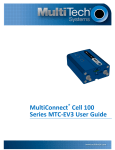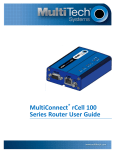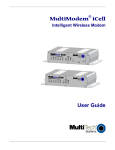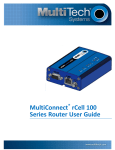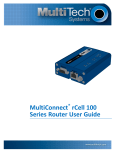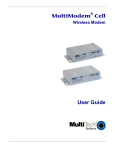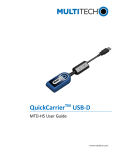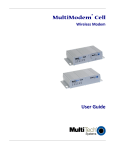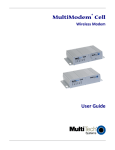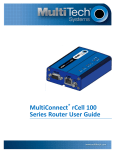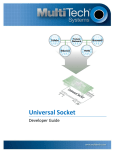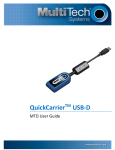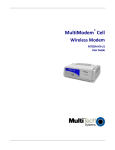Download Multitech MTCMR-G2 User guide
Transcript
MultiModem® iCell MTCMR User Guide MULTIMODEM® ICELL USER GUIDE MultiModem® iCell User Guide Models: MTCMR-E1, -C1, -C2 -G2, -H5, -EV2, -EV3, optional -GP builds Part Number: S000484, Version 9.3 Copyright This publication may not be reproduced, in whole or in part, without the specific and express prior written permission signed by an executive officer of Multi-Tech Systems, Inc. All rights reserved. Copyright © 2013 by Multi-Tech Systems, Inc. Multi-Tech Systems, Inc. makes no representations or warranties, whether express, implied or by estoppels, with respect to the content, information, material and recommendations herein and specifically disclaims any implied warranties of merchantability, fitness for any particular purpose and noninfringement. Multi-Tech Systems, Inc. reserves the right to revise this publication and to make changes from time to time in the content hereof without obligation of Multi-Tech Systems, Inc. to notify any person or organization of such revisions or changes. Legal Notices The Multi-Tech products are not designed, manufactured or intended for use, and should not be used, or sold or re-sold for use, in connection with applications requiring fail-safe performance or in applications where the failure of the products would reasonably be expected to result in personal injury or death, significant property damage, or serious physical or environmental damage. Examples of such use include life support machines or other life preserving medical devices or systems, air traffic control or aircraft navigation or communications systems, control equipment for nuclear facilities, or missile, nuclear, biological or chemical weapons or other military applications (“Restricted Applications”). Use of the products in such Restricted Applications is at the user’s sole risk and liability. MULTI-TECH DOES NOT WARRANT THAT THE TRANSMISSION OF DATA BY A PRODUCT OVER A CELLULAR COMMUNICATIONS NETWORK WILL BE UNINTERRUPTED, TIMELY, SECURE OR ERROR FREE, NOR DOES MULTI-TECH WARRANT ANY CONNECTION OR ACCESSIBILITY TO ANY CELLULAR COMMUNICATIONS NETWORK. MULTI-TECH WILL HAVE NO LIABILITY FOR ANY LOSSES, DAMAGES, OBLIGATIONS, PENALTIES, DEFICIENCIES, LIABILITIES, COSTS OR EXPENSES (INCLUDING WITHOUT LIMITATION REASONABLE ATTORNEYS FEES) RELATED TO TEMPORARY INABILITY TO ACCESS A CELLULAR COMMUNICATIONS NETWORK USING THE PRODUCTS. Trademarks The Multi-Tech logo and MultiModem are a registered trademarks of Multi-Tech Systems, Inc. All other brand and product names are trademarks or registered trademarks of their respective companies. Contacting Multi-Tech Knowledge Base The Knowledge Base provides immediate access to support information and resolutions for all Multi-Tech products. Visit http://www.multitech.com/kb.go. Support Portal To create an account and submit a support case directly to our technical support team, visit: https://support.multitech.com. Support Business Hours: M-F, 8am to 5pm CT Country By Email By Phone Europe, Middle East, Africa: [email protected] +(44) 118 959 7774 U.S., Canada, all others: [email protected] (800) 972-2439 or (763) 717-5863 Warranty To read the warranty statement for your product, visit www.multitech.com/warranty.go. For other warranty options, visit www.multitech.com/es.go. World Headquarters Multi-Tech Systems, Inc. 2205 Woodale Drive, Mounds View, MN 55112 Phone: (800) 328-9717 or (763) 785-3500 Fax (763) 785-9874 2 MultiModem® iCell MTCMR User Guide CONTENTS Contents Product Overview .................................................................................................................................................... 6 Overview ....................................................................................................................................................................... 6 Model Options ............................................................................................................................................................ 6 Related Documentation .............................................................................................................................................. 6 Package Contents........................................................................................................................................................ 7 Safety Notices and Warnings ................................................................................................................................... 8 General Safety............................................................................................................................................................... 8 Radio Frequency (RF) Safety ......................................................................................................................................... 8 Sécurité relative au bâti .............................................................................................................................................. 8 Interference with Pacemakers and Other Medical Devices ........................................................................................ 9 Potential interference ................................................................................................................................................. 9 Precautions for pacemaker wearers .......................................................................................................................... 9 Vehicle Safety................................................................................................................................................................ 9 User Responsibility...................................................................................................................................................... 10 Device Maintenance ................................................................................................................................................... 10 LEDs, Connectors, and Specifications ..................................................................................................................... 11 Front............................................................................................................................................................................ 11 LEDs........................................................................................................................................................................... 11 Back ............................................................................................................................................................................. 12 MTCMR-H5 Specifications........................................................................................................................................... 13 MTCMR-EV3 Specifications ......................................................................................................................................... 14 MTCMR-EV2 Specifications ......................................................................................................................................... 15 MTCMR-G2 Specifications........................................................................................................................................... 17 MTCMR-C1 Specifications ........................................................................................................................................... 18 MTCMR-C2 Specifications ........................................................................................................................................... 19 MTCMR-E1 Specifications ........................................................................................................................................... 20 Power Measurements................................................................................................................................................. 23 MTCMR-H5................................................................................................................................................................ 23 MTCMR-H5-GP .......................................................................................................................................................... 24 MTCMR-EV3 .............................................................................................................................................................. 24 MTCMR-EV3-GP ........................................................................................................................................................ 25 MTCMR-EV2 .............................................................................................................................................................. 26 MTCMR-EV2 .............................................................................................................................................................. 27 MTCMR-G2................................................................................................................................................................ 28 MTCMR-G2-GP .......................................................................................................................................................... 28 MTCMR-C1 ................................................................................................................................................................ 28 MTCMR-C1-GP .......................................................................................................................................................... 29 MultiModem® iCell MTCMR User Guide 3 CONTENTS MTCMR-C2 ................................................................................................................................................................ 29 MTCMR-C2-GP .......................................................................................................................................................... 30 MTCMR-E1 ................................................................................................................................................................ 30 MTCMR-E1-GP........................................................................................................................................................... 30 RF Specifications ......................................................................................................................................................... 31 Antenna Information................................................................................................................................................... 31 PTCRB Requirements ................................................................................................................................................ 31 Cellular Antenna Information ................................................................................................................................... 31 EV-DO and CDMA Antenna Information................................................................................................................... 32 GSM/EGSM Antenna Requirements/Specifications ................................................................................................. 33 FCC Requirements Note............................................................................................................................................ 33 Global Positioning System (GPS) .............................................................................................................................. 33 Connecting Direct DC Power accessories.................................................................................................................... 34 GPIO ............................................................................................................................................................................ 35 GPIO Cable ................................................................................................................................................................ 35 GPIO Connector ........................................................................................................................................................ 35 RS-232 9-Pin Female Connector ................................................................................................................................. 36 Device Activation and Installation.......................................................................................................................... 38 Account Activation for Cellular Devices ..................................................................................................................... 38 Device Phone Number ................................................................................................................................................ 38 Notice for Devices that Use Aeris Radios.................................................................................................................... 38 Installing and Removing SIM Cards............................................................................................................................. 38 Installing a SIM Card ................................................................................................................................................. 38 Removing a SIM Card................................................................................................................................................ 39 Attaching Power Supply Blades .................................................................................................................................. 39 Power Supply and Blades.......................................................................................................................................... 39 Attaching the Blades ................................................................................................................................................. 39 Connecting Antennas, Cables, and Power ................................................................................................................. 40 Connecting Direct DC Power accessories.................................................................................................................... 40 Mounting the Device on a Flat Surface....................................................................................................................... 40 Installing Drivers.......................................................................................................................................................... 41 Verifying that Modem Installed Successfully in Windows ....................................................................................... 42 Basic Operations .................................................................................................................................................... 43 Device Phone Number ................................................................................................................................................ 43 Sending AT Commands ............................................................................................................................................... 43 Verifying Signal Strength............................................................................................................................................. 43 Example .................................................................................................................................................................... 44 Checking Network Registration................................................................................................................................... 44 Checking Network Registration for EV2 and C2........................................................................................................ 44 Connecting to the Internet ......................................................................................................................................... 44 Creating a Windows Dial-Up Connection.................................................................................................................. 45 4 MultiModem® iCell MTCMR User Guide CONTENTS Setting the Access Point Number (APN) in Modem's Properties ............................................................................ 45 Creating a Dial-up Connection in Linux..................................................................................................................... 45 Setting the Serial Baud Rate ....................................................................................................................................... 45 Recovery ................................................................................................................................................................... 46 Regulatory Statements .......................................................................................................................................... 47 EMC, Safety, and R&TTE Directive Compliance ......................................................................................................... 47 International Modem Restrictions .............................................................................................................................. 47 47 CFR Part 15 Regulation Class B Devices ................................................................................................................. 47 Industry Canada Class B Notice................................................................................................................................... 47 Environmental Notices........................................................................................................................................... 49 Waste Electrical and Electronic Equipment Statement .............................................................................................. 49 WEEE Directive.......................................................................................................................................................... 49 Instructions for Disposal of WEEE by Users in the European Union ........................................................................ 49 REACH Statement ....................................................................................................................................................... 50 Registration of Substances........................................................................................................................................ 50 Substances of Very High Concern (SVHC) ................................................................................................................ 50 Restriction of the Use of Hazardous Substances (RoHS) ............................................................................................ 51 Information on HS/TS Substances According to Chinese Standards ......................................................................... 52 Information on HS/TS Substances According to Chinese Standards (in Chinese) ...................................................... 53 Index...................................................................................................................................................................... 54 MultiModem® iCell MTCMR User Guide 5 PRODUCT OVERVIEW Product Overview Overview MultiModem iCell modems provide wireless data communications and integrate seamlessly with other applications. MultiModem iCell includes Universal IP® stack, which allows users to implement functions such as persistent connectivity and event monitoring. Model Options Model Description MTCMR-E1 Quad-band E-GPRS Class 12 performance MTCMR-E1-GP Quad-band E-GPRS Class 12 performance; GPS MTCMR-C1 Multi-band CDMA2000 1xRTT performance MTCMR-C1-GP Multi-band CDMA2000 1xRTT performance; GPS MTCMR-G2 Quad-band GSM/GPRS Class 10 performance MTCMR-G2-GP Quad-band GSM/GPRS Class 10 performance; GPS MTCMR-H5 Standards based tri-band UMTS/HSPA performance MTCMR-H5-GP Standards based tri-band UMTS/HSPA performance; GPS MTCMR-EV2 Dual-band 800/1900 MHz with receive diversity support on EVDO bands MTCMR-EV2-GP Dual-band 800/1900 MHz with receive diversity support on EVDO bands; GPS MTCMR-EV3 Dual-band 800/1900 MHz with receive diversity support on EVDO bands MTCMR-EV3-GP Dual-band 800/1900 MHz with receive diversity support on EVDO bands; GPS MTCMR-C2 CDMA Modem (RS-232/USB) MTCMR-C2-GP CDMA Modem (RS-232/USB); GPS Related Documentation Use AT Commands to configure your device. The following documentation is available on the Multi-Tech website at www.multitech.com/setup/product.go. 6 Model Document All S000457 Universal IP AT Commands Reference Guide MTCMR-H5 S000574 HSPA+ AT Commands Reference Guide MTCMR-EV3 S000546 EV-DO and CDMA AT Commands Reference Guide MTCMR-EV2 S000482 CDMA 1xEV-DO AT Commands Reference Guide MTCMR-G2 S000463 GPRS G2 Modems AT Commands Reference Guide MTCMR-E1 S000474 Wireless EDGE (E1) Modems AT Commands Reference Guide MTCMR-C1 S000478 CDMA-C1 AT Commands Reference Guide MTCMR-C2 S000546 EV-DO and CDMA AT Commands Reference Guide MultiModem® iCell MTCMR User Guide PRODUCT OVERVIEW Package Contents Note: For HSPA+, EDGE, and GPRS devices, your wireless provider supplies the SIM card. Other models do not use SIM cards. Unbundled Package with No Accessories 1 modem Note: Package does not include mounting screws, AC or DC power supply, and antenna(s). Bundled Package with Accessories 1 modem 1 antenna (-GP builds have an additional GPS antenna) 1 RS-232 cable 1 USB cable 1 GPIO cable 1 power supply (-GP builds do not include power supply) Note: Package does not include mounting screws MultiModem® iCell MTCMR User Guide 7 SAFETY NOTICES AND WARNINGS Safety Notices and Warnings General Safety The modem is designed for and intended to be used in fixed and mobile applications. Fixed means the device is physically secured at one location and cannot be easily moved to another location. Mobile means the device is used in other than fixed locations. CAUTION: Maintain a separation distance of at least 20 cm (8 inches) between the transmitter’s antenna and the body of the user or nearby persons. The modem is not designed for or intended to be used in portable applications within 20 cm (8 inches) of the user’s body. Attention: Maintenir une distance d'au moins 20 cm (8 po) entre l'antenne du récepteur et le corps de l'utilisateur ou à proximité de personnes. Le modem n'est pas conçu pour, ou destinés à être utilisés dans les applications portables, moins de 20 cm du corps de l'utilisateur. Radio Frequency (RF) Safety Due to the possibility of radio frequency (RF) interference, it is important that you follow any special regulations regarding the use of radio equipment. Follow the safety advice given below. ■ Operating your device close to other electronic equipment may cause interference if the equipment is inadequately protected. Observe any warning signs and manufacturers’ recommendations. ■ Different industries and businesses restrict the use of cellular devices. Respect restrictions on the use of radio equipment in fuel depots, chemical plants, or where blasting operations are in process. Follow restrictions for any environment where you operate the device. ■ Do not place the antenna outdoors. ■ Switch OFF your wireless device when in an aircraft. Using portable electronic devices in an aircraft may endanger aircraft operation, disrupt the cellular network, and is illegal. Failing to observe this restriction may lead to suspension or denial of cellular services to the offender, legal action, or both. ■ Switch OFF your wireless device when around gasoline or diesel-fuel pumps and before filling your vehicle with fuel. ■ Switch OFF your wireless device in hospitals and any other place where medical equipment may be in use. Sécurité relative au bâti Lors de l'installation de l'unité dans une enceinte pouvant en héberger plusieurs, suivez la procédure d'installation du fabricant de l'enceinte. Note: La température ambiante à l'intérieur du bâti ne doit pas dépasser 40° Celsius. ■ Ne placez pas l'unité directement sur le dessus ou en dessous d'un autre équipement. ■ Si l'unité est installée dans une enceinte pouvant en héberger plusieurs, veillez à ce que l'air circule correctement dans le bâti afin que la température ambiante maximale recommandée (40° C) ne soit pas dépassée. ■ Veillez à ce que l'unité soit correctement mise à la terre en vérifiant la fiabilité du raccordement de terre lorsque l'unité est installée dans un bâti. ■ Si une multiprise est utilisée, veillez à ce qu'elle fournisse une mise à la terre appropriée à l'appareil qui y est branché. 8 MultiModem® iCell MTCMR User Guide SAFETY NOTICES AND WARNINGS ■ Lors de l'installation de l'équipement dans un bâti, veillez à ce que la charge mécanique soit homogène de sorte à éviter toute situation potentiellement dangereuse. Le bâti doit supporter le poids de l'ensemble des équipements qu'il contient. ■ Assurez-vous que le circuit d'alimentation principale est capable de gérer la charge de l'équipement. Consultez l'étiquette d'alimentation sur l'équipement pour connaître les spécifications relatives aux charges. ■ Cet équipement ne doit être installé que par un technicien de maintenance dûment qualifié. Ne raccordez des circuits que s'ils sont du même type: raccordez un circuit STBT (Secondaire Très Basse Tension) à un autre circuit STBT et un circuit RT (Réseau de télécommunications) à un autre circuit RT. Interference with Pacemakers and Other Medical Devices Potential interference Radiofrequency energy (RF) from cellular devices can interact with some electronic devices. This is electromagnetic interference (EMI). The FDA helped develop a detailed test method to measure EMI of implanted cardiac pacemakers and defibrillators from cellular devices. This test method is part of the Association for the Advancement of Medical Instrumentation (AAMI) standard. This standard allows manufacturers to ensure that cardiac pacemakers and defibrillators are safe from cellular device EMI. The FDA continues to monitor cellular devices for interactions with other medical devices. If harmful interference occurs, the FDA will assess the interference and work to resolve the problem. Precautions for pacemaker wearers If EMI occurs, it could affect a pacemaker in one of three ways: ■ Stop the pacemaker from delivering the stimulating pulses that regulate the heart's rhythm. ■ Cause the pacemaker to deliver the pulses irregularly. ■ Cause the pacemaker to ignore the heart's own rhythm and deliver pulses at a fixed rate. Based on current research, cellular devices do not pose a significant health problem for most pacemaker wearers. However, people with pacemakers may want to take simple precautions to be sure that their device doesn't cause a problem. ■ Keep the device on the opposite the side of the body from the pacemaker to add extra distance between the pacemaker and the device. ■ Avoid placing a turned-on device next to the pacemaker (for example, don’t carry the device in a shirt or jacket pocket directly over the pacemaker). Vehicle Safety When using your device in a vehicle: ■ Do not use this device while driving. ■ Respect national regulations on the use of cellular devices in vehicles. ■ If incorrectly installed in a vehicle, operating the wireless device could interfere with the vehicle’s electronics. To avoid such problems, use qualified personnel to install the device. The installer should verify the vehicle electronics are protected from interference. ■ Using an alert device to operate a vehicle’s lights or horn is not permitted on public roads. MultiModem® iCell MTCMR User Guide 9 SAFETY NOTICES AND WARNINGS ■ UL evaluated this device for use in ordinary locations only. UL did NOT evaluate this device for installation in a vehicle or other outdoor locations. UL Certification does not apply or extend to use vehicles or outdoor applications or in ambient temperatures above 40° C. User Responsibility Respect all local regulations for operating your wireless device. Use the security features to block unauthorized use and theft. Device Maintenance When maintaining your device: ■ Do not attempt to disassemble the device. There are no user serviceable parts inside. ■ Do not expose your device to any extreme environment where the temperature or humidity is high. ■ Do not expose the device to water, rain, or spilled beverages. It is not waterproof. ■ Do not place the device alongside computer discs, credit or travel cards, or other magnetic media. The information contained on discs or cards may be affected by the device. ■ Using accessories, such as antennas, that Multi-Tech has not authorized or that are not compliant with Multi-Tech's accessory specifications may invalidate the warranty. If the device is not working properly, contact Multi-Tech Technical Support. 10 MultiModem® iCell MTCMR User Guide LEDS, CONNECTORS, AND SPECIFICATIONS LEDs, Connectors, and Specifications Front MTCMR-E1, -G2, -H5 MTCMR-C1, -C2, -EV2, -EV3 LEDs LED Description TD Transmit Data: Lights when device transmits data. Not valid while in USB mode. RD Receive Data: Lights when device receives data. Not valid while in USB mode. CD Carrier Detect: Lights when there is a data connection. Not valid while in USB mode. LS Link Status: LED behavior depends on model. H5, C2, EV3, and EV2 models G2 and C1 models Continuous ON indicates device is powered on and registered on the network. Continuous ON indicates Continuous ON indicates connected to device is not registered on the remote party (CSD call). network. Slow flashing (5 seconds) indicates device is on and searching for a network. Flashing at 200 ms on / 2 sec indicates registration on network. Flashing at 600 ms on/600 ms off is limited network service: No SIM card inserted or no PIN entered, or network search in progress or ongoing user authentication, or network login in progress. Fast flashing (0.3 seconds) indicates device is transmitting or receiving. Flashing at 200 ms on / 600 ms off indicates it is registered on a network and communication is in progress. Flashing at 75 ms on/3 sec off is idle mode: Registered to the GSM network (monitoring control channels and user interactions). No call is in progress. MultiModem® iCell MTCMR User Guide E1 model Note: Set AT^SSYNC to 1 for the following default LED timings: 11 LEDS, CONNECTORS, AND SPECIFICATIONS LED Description OFF indicates device is turned off or not powered. OFF indicates device is turned off or in download mode. Flashing at 75 ms on/ 75 ms off/75 ms on/3 sec off indicates one or more GPRS contexts activated. Flashing at 500 ms on/ 25 ms off indicates packet switched data transfer in progress. OFF indicates ME is in one of the following modes: power down mode, airplane mode, non-cyclic sleep mode with no temporary wake-up event in progress. TR Terminal Ready: Indicates a readiness signal from the PC. PWR/GPS Power: Lights device has DC power. GPS: If device has valid GPS signal, LED blinks at 1 second ON and 0.5 second OFF. If invalid GPS signal, LED is solid. Signal ■ ALL OFF – Unit is off, not registered on a network or has an extremely weak signal (0 < = RSSI < 6). ■ 1 Bar ON – Very weak signal (7 < = RSSI < 14) ■ 1 and 2 Bars ON – Weak signal (15 < = RSSI < 23) ■ 1, 2, and 3 Bars ON – Good signal (24 < = RSSI < 31) Back MTCMR No GPS 12 MTCMR with GPS MultiModem® iCell MTCMR User Guide LEDS, CONNECTORS, AND SPECIFICATIONS MTCMR-H5 Specifications Category Description General Performance HSPA+ Frequency Bands Penta band 850/900/1700/1900/2100 MHz Speed Packet Data HSDPA data service of up to 21.0 Mbps HSUPA data service of up to 5.76 Mbps Physical Description Weight 0.45 lbs. (200 g) Dimensions 3.1 in x 4.9 in x 1.1 in (7.9 cm x 12.4 cm x 2.8 cm) Connectors Cellular 50 ohm SMA (female connector) RS-232 DE9 GPIO 6 pin 2x3 style Power 2.5mm miniature (screw-on) USB Type B SIM Holder Standard 1.8V and 3V Environment Operating Temperature -22° to 158° F (-30° to 70° C)1 Humidity 20%-90% relative humidity, non-condensing Power Requirements Voltage 9V to 32V DC SMS SMS Point-to-Point messaging Text and PDU Cell broadcast Certifications and Compliance EMC Compliance FCC Part 15 Class B EN55022 Class B MultiModem® iCell MTCMR User Guide 13 LEDS, CONNECTORS, AND SPECIFICATIONS Category Description Radio Compliance FCC Part 22 FCC Part 24 RSS 132 RSS 133 EN 301 511 EN 301 489-1 EN 301 489-3 (GPS models only) EN 301 489-7 EN 301 489-24 EN 301 908 AS/ACIF S042.1, S042.3 Safety Compliance UL/cUL 60950-1 2nd Ed IEC60950-1 2nd Ed am.1 Network Compliance PTCRB AT&T 1 UL Listed at 40° C, limited by power supply. UL Certification does not apply or extend to an ambient above 40° C and has not been evaluated by UL for ambient greater than 40° C. “UL has evaluated this device for use in ordinary locations only. Installation in a vehicle or other outdoor locations has not been evaluated by UL. UL Certification does not apply or extend to use in vehicles or outdoor applications or in ambient above 40° C.” MTCMR-EV3 Specifications Category Description General Performance EV-DO Rev A Frequency Bands Dual band 900/1800 MHz Speed Packet Data Up to 3.1M downlink and 5.76M bps uplink Physical Description Weight 0.45 lbs. (200 g) Dimensions 3.1 in x 4.9 in x 1.1 in (7.9 cm x 12.4 cm x 2.8 cm) Connectors 14 Cellular 50 ohm SMA (female connector) RS-232 DE9 GPIO 6 pin 2x3 style MultiModem® iCell MTCMR User Guide LEDS, CONNECTORS, AND SPECIFICATIONS Category Description Power 2.5mm miniature (screw-on) USB Type B Environment Operating Temperature -22° to 185° F (-30° to 85° C)1 Humidity 20%-90% relative humidity, non-condensing Power Requirements Voltage 9V to 32V DC SMS SMS Point-to-Point messaging Text and PDU Cell broadcast Certifications and Compliance EMC Compliance FCC Part 15 Class B EN55022 Class B EN55024 Radio Compliance FCC Part 22 FCC Part 24 Safety Compliance UL/cUL 60950-1 2nd Ed IEC60950-1 2nd Ed am.1 1 UL Listed at 40° C, limited by power supply. UL Certification does not apply or extend to an ambient above 40° C and has not been evaluated by UL for ambient greater than 40° C. “UL has evaluated this device for use in ordinary locations only. Installation in a vehicle or other outdoor locations has not been evaluated by UL. UL Certification does not apply or extend to use in vehicles or outdoor applications or in ambient above 40° C.” MTCMR-EV2 Specifications Category Description General Performance EV-DO Rev A backwards compatible to EV-DO Rev 0 and CDMA2000 1xRTT Frequency Bands Dual band 800/1900 MHz Speed Packet Data Up to 3.1 Kbps download and 1.8 Kbps upload. Circuit Switched Data IS-95A, IS-95B up to 14.4K bps Physical Description Weight 0.45 lbs. (200 g) MultiModem® iCell MTCMR User Guide 15 LEDS, CONNECTORS, AND SPECIFICATIONS Category Description Dimensions 3.1 in x 4.9 in x 1.1 in (7.9 cm x 12.4 cm x 2.8 cm) Connectors Cellular 50 ohm SMA (female connector) RS-232 DE9 GPIO 6 pin 2x3 style Power 2.5mm miniature (screw-on) USB Type B Environment Operating Temperature -22° to 185° F (-30° to 85° C)1 Humidity 20%-90% relative humidity, non-condensing Power Requirements Voltage 9V to 32V DC SMS, Wi-Fi, Bluetooth SMS Point-to-Point messaging Text and PDU Certifications and Compliance EMC Compliance FCC Part 15 Class B EN55022 Class B Radio Compliance FCC Part 22 FCC Part 24 Safety Compliance UL 60950-1 2nd Ed IEC60950-1 2nd Ed am.1 1 UL Listed at 40° C, limited by power supply. UL Certification does not apply or extend to an ambient above 40° C and has not been evaluated by UL for ambient greater than 40° C. “UL has evaluated this device for use in ordinary locations only. Installation in a vehicle or other outdoor locations has not been evaluated by UL. UL Certification does not apply or extend to use in vehicles or outdoor applications or in ambient above 40° C.” 16 MultiModem® iCell MTCMR User Guide LEDS, CONNECTORS, AND SPECIFICATIONS MTCMR-G2 Specifications Category Description General Performance GPRS: Class 10 Frequency Bands Quad-band GSM/GPRS/EDGE: 850/900/1800/1900 MHz Speed Packet Data Up to 85.6K bps, coding schemes CS1 to CS4 Circuit Switched Data Up to 14.4 Kbps transparent and non-transparent Physical Description Weight 0.45 lbs. (200 g) Dimensions 3.1 in x 4.9 in x 1.1 in (7.9 cm x 12.4 cm x 2.8 cm) Connectors Cellular 50 ohm SMA (female connector) RS-232 DE9 GPIO 6 pin 2x3 style Power 2.5mm miniature (screw-on) USB Type B SIM Holder Standard 1.8V and 3V Environment Operating Temperature -40° to 185° F (-40° to 85° C)1 Humidity 20%-90% relative humidity, non-condensing Power Requirements Voltage 9V to 32V DC SMS, Wi-Fi, Bluetooth SMS Point-to-Point messaging Text and PDU Cell broadcast Certifications and Compliance EMC Compliance FCC Part 15 Class B EN55022 Class B MultiModem® iCell MTCMR User Guide 17 LEDS, CONNECTORS, AND SPECIFICATIONS Category Description Radio Compliance FCC Part 22 FCC Part 24 RSS 132 RSS 133 EN 301 511 EN 301 489-1 EN 301 489-3 (GPS models only) EN 301 489-7 EN 301 908 AS/ACIF S042.1, S042.3 Safety Compliance UL/cUL 60950-1 2nd Ed IEC60950-1 2nd Ed am.1 Network Compliance PTCRB AT&T 1 UL Listed at 40° C, limited by power supply. UL Certification does not apply or extend to an ambient above 40° C and has not been evaluated by UL for ambient greater than 40° C. “UL has evaluated this device for use in ordinary locations only. Installation in a vehicle or other outdoor locations has not been evaluated by UL. UL Certification does not apply or extend to use in vehicles or outdoor applications or in ambient above 40° C.” MTCMR-C1 Specifications Category Description General Performance CDMA2000 1xRTT Frequency Bands Dual band 800/1900 MHz Speed Packet Data Up to 153.6K bps forward and reverse Circuit Switched Data IS-95A, IS-95B up to 14.4K bps forward and reverse Physical Description Weight 0.45 lbs. (200 g) Dimensions 3.1 in x 4.9 in x 1.1 in (7.9 cm x 12.4 cm x 2.8 cm) Connectors 18 Cellular 50 ohm SMA (female connector) RS-232 DE9 GPIO 6 pin 2x3 style MultiModem® iCell MTCMR User Guide LEDS, CONNECTORS, AND SPECIFICATIONS Category Description Power 2.5mm miniature (screw-on) USB Type B Environment Operating Temperature -40° to 185° F (-40° to 85° C)1 Humidity 20%-90% relative humidity, non-condensing Power Requirements Voltage 9V to 32V DC SMS SMS Point-to-Point messaging Text and PDU Cell broadcast Certifications and Compliance EMC Compliance FCC Part 15 Class B EN55022 Class B Radio Compliance FCC Part 22 FCC Part 24 RSS 132 RSS 133 Safety Compliance UL/cUL 60950-1 2nd Ed IEC60950-1 2nd Ed am.1 1 UL Listed at 40° C, limited by power supply. UL Certification does not apply or extend to an ambient above 40° C and has not been evaluated by UL for ambient greater than 40° C. “UL has evaluated this device for use in ordinary locations only. Installation in a vehicle or other outdoor locations has not been evaluated by UL. UL Certification does not apply or extend to use in vehicles or outdoor applications or in ambient above 40° C.” MTCMR-C2 Specifications Category Description General Performance 2G CDMA 1xRTT Frequency Bands Dual-band 800/1900 MHz CDMA Speed Packet Data Peak downlink speeds up to 153 Kbps Peak uplink speeds up to 153 Kbps Physical Description Weight 0.45 lbs. (200 g) MultiModem® iCell MTCMR User Guide 19 LEDS, CONNECTORS, AND SPECIFICATIONS Category Description Dimensions 3.1 in x 4.9 in x 1.1 in (7.9 cm x 12.4 cm x 2.8 cm) Connectors Cellular 50 ohm SMA (female connector) RS-232 DE9 GPIO 6 pin 2x3 style Power 2.5mm miniature (screw-on) USB Type B Environment Operating Temperature -22° to 185° F (-30° to 85° C)1 Humidity 20%-90% relative humidity, non-condensing Power Requirements Voltage 9V to 32V DC SMS SMS Point-to-Point messaging Text and PDU Certifications and Compliance EMC Compliance FCC Part 15 Class B EN55022 Class B Radio Compliance FCC Part 22 FCC Part 24 Safety Compliance UL/cUL 60950-1 2nd Ed IEC60950-1 2nd Ed am.1 1 UL Listed at 40° C, limited by power supply. UL Certification does not apply or extend to an ambient above 40° C and has not been evaluated by UL for ambient greater than 40° C. “UL has evaluated this device for use in ordinary locations only. Installation in a vehicle or other outdoor locations has not been evaluated by UL. UL Certification does not apply or extend to use in vehicles or outdoor applications or in ambient above 40° C.” MTCMR-E1 Specifications Category Description General Performance EDGE: E-GPRS Class 12 GPRS: Class 10 Frequency Bands Quad-band GSM/GPRS/EDGE: 850/900/1800/1900 MHz Speed 20 MultiModem® iCell MTCMR User Guide LEDS, CONNECTORS, AND SPECIFICATIONS Category Description Packet Data EDGE: E-GPRS Up to 240K bps, coding scheme MCS 1-9, mobile station Class B, LLC layer, 4 time slots. GPRS: Full PBCCH support, coding scheme 1-4, mobile station Class B Circuit Switched Data Up to 14.4K bps, non-transparent Physical Description Weight 0.45 lbs. (200 g) Dimensions 3.1 in x 4.9 in x 1.1 in (7.9 cm x 12.4 cm x 2.8 cm) Connectors Cellular 50 ohm SMA (female connector) RS-232 DE9 GPIO 6 pin 2x3 style Power 2.5mm miniature (screw-on) USB Type B SIM Holder Standard 1.8V and 3V Environment Operating Temperature -22° to 158° F (-30° to 70° C)1 Humidity 20%-90% relative humidity, non-condensing Power Requirements Voltage 9V to 32V DC SMS, Wi-Fi, Bluetooth SMS Point-to-Point messaging Text and PDU Cell broadcast Certifications and Compliance EMC Compliance EN55022 Class B MultiModem® iCell MTCMR User Guide 21 LEDS, CONNECTORS, AND SPECIFICATIONS Category Description Radio Compliance FCC Part 22 FCC Part 24 RSS 132 RSS 133 EN 301 511 EN 301 489-1 EN 301 489-3 (GPS models only) EN 301 489-7 EN 301 908 AS/ACIF S042.1, S042.3 Safety Compliance UL/cUL 60950-1 2nd Ed IEC60950-1 2nd Ed am.1 Network Compliance PTCRB AT&T 1 UL Listed at 40° C, limited by power supply. UL Certification does not apply or extend to an ambient above 40° C and has not been evaluated by UL for ambient greater than 40° C. “UL has evaluated this device for use in ordinary locations only. Installation in a vehicle or other outdoor locations has not been evaluated by UL. UL Certification does not apply or extend to use in vehicles or outdoor applications or in ambient above 40° C.” 22 MultiModem® iCell MTCMR User Guide LEDS, CONNECTORS, AND SPECIFICATIONS Power Measurements Multi-Tech Systems, Inc. recommends that you incorporate a 10% buffer into your power source when determining product load. Note: Note the following: ■ Maximum: The continuous current during maximum data rate with the radio transmitter at maximum power. ■ Peak: The peak current during a transmission burst period. ■ In-rush Current: The input current during power up, or a reset. MTCMR-H5 GSM 850 Idle Typical Maximum Peak TX In-rush Current Current (AMPS) 0.057 0.080 0.185 1.18 1.61 Watts 0.526 0.740 1.700 Current (AMPS) 0.030 0.044 0.087 0.530 1.71 Watts 0.600 0.880 1.740 Current (AMPS) 0.021 0.031 0.054 0.332 1.46 Watts 0.672 0.992 1.73 Idle Typical Maximum Peak TX In-rush Current Current (AMPS) 0.057 0.140 0.270 0.340 1.61 Watts 0.526 1.290 2.47 Current (AMPS) 0.030 0.070 0.131 0.196 1.71 Watts 0.600 1.400 2.62 Current (AMPS) 0.021 0.048 0.086 0.152 1.46 Watts 0.672 1.54 2.75 9 volts 20 volts 32 volts HSPA+ 9 volts 20 volts 32 volts MultiModem® iCell MTCMR User Guide 23 LEDS, CONNECTORS, AND SPECIFICATIONS MTCMR-H5-GP GSM 850 Idle Typical Maximum Peak TX In-rush Current Current (AMPS) 0.097 0.125 0.225 1.32 1.63 Watts 0.895 1.150 2.070 Current (AMPS) 0.051 0.063 0.108 0.570 1.74 Watts 1.020 1.260 2.160 Current (AMPS) 0.035 0.043 0.072 0.340 1.47 Watts 1.120 1.380 2.300 Idle Typical Maximum Peak TX In-rush Current Current (AMPS) 0.096 0.182 0.310 0.384 1.63 Watts 0.890 1.670 2.840 Current (AMPS) 0.051 0.092 0.153 0.220 1.74 Watts 1.020 1.840 3.060 Current (AMPS) 0.035 0.062 0.100 0.164 1.47 Watts 1.120 1.980 3.200 9 volts 20 volts 32 volts HSPA+ 9 volts 20 volts 32 volts MTCMR-EV3 CDMA 2000 Typical Maximum Peak TX In-rush Current Current (AMPS) 0.121 0.330 0.404 2.55 Watts 1.09 2.97 Current (AMPS) 0.061 0.155 0.228 1.89 Watts 1.22 3.10 9 volts 20 volts 32 volts 24 MultiModem® iCell MTCMR User Guide LEDS, CONNECTORS, AND SPECIFICATIONS Typical Maximum Peak TX In-rush Current Current (AMPS) 0.045 0.107 0.176 1.70 Watts 1.44 3.42 Typical Maximum Peak TX In-rush Current Current (AMPS) 0.118 0.275 0.360 2.55 Watts 1.06 2.48 Current (AMPS) 0.061 0.133 0.204 1.89 Watts 1.22 2.66 Current (AMPS) 0.043 0.091 0.156 1.70 Watts 1.38 2.91 EV-DO 9 volts 20 volts 32 volts MTCMR-EV3-GP CDMA 2000 Typical Maximum Peak TX In-rush Current Current (AMPS) 0.160 0.354 0.430 2.42 Watts 1.44 3.19 Current (AMPS) 0.086 0.173 0.24 1.86 Watts 1.72 3.46 Current (AMPS) 0.049 0.110 0.18 1.65 Watts 1.57 3.52 Typical Maximum Peak TX In-rush Current Current (AMPS) 0.168 0.330 0.412 2.42 Watts 1.51 2.97 9 volts 20 volts 32 volts EV-DO 9 volts 20 volts MultiModem® iCell MTCMR User Guide 25 LEDS, CONNECTORS, AND SPECIFICATIONS Typical Maximum Peak TX In-rush Current Current (AMPS) 0.084 0.158 0.232 1.86 Watts 1.68 3.16 Current (AMPS) 0.056 0.105 0.176 1.65 Watts 1.79 3.36 Sleep Typical Maximum Current (AMPS) 0.061 0.160 0.485 Watts 0.56 1.47 4.41 Current (AMPS) 0.030 0.081 0.230 Watts 0.60 1.62 4.60 Current (AMPS) 0.023 0.055 0.152 Watts 0.74 1.76 4.86 Sleep Typical Maximum Current (AMPS) 0.108 0.330 0.580 Watts 1.00 3.04 5.27 Current (AMPS) 0.052 0.165 0.313 Watts 1.04 3.30 6.26 Current (AMPS) 0.041 0.105 0.205 Watts 1.31 3.36 6.56 32 volts MTCMR-EV2 CDMA 2000 9 volts 20 volts 32 volts EV-DO 9 volts 20 volts 32 volts 26 MultiModem® iCell MTCMR User Guide LEDS, CONNECTORS, AND SPECIFICATIONS MTCMR-EV2 CDMA 2000 Sleep Typical Maximum Current (AMPS) 0.119 0.220 0.560 Watts 1.10 2.02 5.09 Current (AMPS) 0.062 0.110 0.265 Watts 1.24 2.20 5.30 Current (AMPS) 0.044 0.075 0.175 Watts 1.141 2.40 5.60 Sleep Typical Maximum Current (AMPS) 0.167 0.370 0.625 Watts 1.54 3.40 5.68 Current (AMPS) 0.087 0.192 0.345 Watts 1.74 3.84 6.90 Current (AMPS) 0.062 0.121 0.225 Watts 1.198 3.87 7.20 9 volts 20 volts 32 volts EV-DO 9 volts 20 volts 32 volts MultiModem® iCell MTCMR User Guide 27 LEDS, CONNECTORS, AND SPECIFICATIONS MTCMR-G2 Sleep Typical Maximum Peak TX Current (AMPS) 0.069 0.109 0.194 1.53 Watts 0.640 1.010 1.790 Current (AMPS) 0.038 0.056 0.096 Watts 0.760 1.120 1.920 Current (AMPS) 0.030 0.041 0.065 Watts 0.960 1.300 2.100 Sleep Typical Maximum Peak TX Current (AMPS) 0.083 0.130 0.233 1.83 Watts 0.770 1.190 2.130 Current (AMPS) 0.046 0.067 0.115 Watts 0.920 1.340 2.300 Current (AMPS) 0.036 0.050 0.078 Watts 1.150 1.600 2.500 9 volts 20 volts 0.668 32 volts 0.453 MTCMR-G2-GP 9 volts 20 volts 0.801 32 volts 0.543 MTCMR-C1 Sleep Typical Maximum Current (AMPS) 0.048 0.128 0.360 Watts 0.44 1.18 3.31 Current (AMPS) 0.027 0.065 0.171 Watts 0.54 1.30 3.42 0.021 0.046 0.115 9 volts 20 volts 32 volts Current (AMPS) 28 MultiModem® iCell MTCMR User Guide LEDS, CONNECTORS, AND SPECIFICATIONS Sleep Typical Maximum 0.67 1.47 3.68 Sleep Typical Maximum Current (AMPS) 0.096 0.175 0.435 Watts 0.89 1.62 4.00 Current (AMPS) 0.052 0.092 0.205 Watts 1.04 1.84 4.10 Current (AMPS) 0.037 0.062 0.135 Watts 1.18 1.98 4.32 Watts MTCMR-C1-GP 9 volts 20 volts 32 volts MTCMR-C2 Idle Typical Maximum Peak Inrush Curren 0.079 t (AMPS) 0.118 0.424 0.463 2.09 Watts 1.09 3.03 Curren 0.042 t (AMPS) 0.054 0.195 0.239 1.81 Watts 1.10 3.06 Curren 0.029 t (AMPS) 0.051 0.137 0.176 1.35 Watts 1.63 4.38 9 volts PCS (1900 MHz) 0.73 20 volts PCS (1900 MHz) 0.0.84 32 volts PCS (1900 MH) 0.93 MultiModem® iCell MTCMR User Guide 29 LEDS, CONNECTORS, AND SPECIFICATIONS MTCMR-C2-GP Idle Typical Maximum Peak Inrush Curren t Curren 0.119 t (AMPS) 0.158 0.448 0.488 2.09 Watts 1.46 4.10 Curren 0.061 t (AMPS) 0.079 0.213 0.252 1.81 Watts 1.58 4.26 Curren 0.043 t (AMPS) 0.055 0.140 0.18 1.35 Watts 1.76 4.48 9 volts PCS (1900 MHz) 1.10 20 volts PCS (1900 MHz) 1.22 32 volts PCS (1900 MH) 1.38 MTCMR-E1 Sleep Typical Maximum Peak TX Current (AMPS) 0.091 0.149 0.416 2.5 Watts 0.84 1.37 3.77 Current (AMPS) 0.048 0.077 0.190 Watts 0.96 1.54 3.80 Current (AMPS) 0.034 0.054 0.124 Watts 1.088 1.73 3.97 Sleep Typical Maximum Peak TX Current (AMPS) 0.098 0.160 0.410 2.25 Watts 0.91 1.48 3.77 9 volts 20 volts 0.895 32 volts 0.625 MTCMR-E1-GP 9 volts 30 MultiModem® iCell MTCMR User Guide LEDS, CONNECTORS, AND SPECIFICATIONS Sleep Typical Maximum Peak TX Current (AMPS) 0.051 0.080 0.190 0.890 Watts 1.02 1.60 3.80 Current (AMPS) 0.035 0.056 0.122 Watts 1.125 1.79 3.90 20 volts 32 volts 0.609 RF Specifications GSM 850 EGSM 900 GSM 1800 GSM 1900 CDMA 800 CDMA 1900 Frequency RX 869 to 894 MHz 925 to 960 MHz 1805 to 1800 MHz 1930 to 1990 MHz 869 to 894 MHz 1930 to 1990 MHz Frequency TX 824 to 849 MHz 880 to 915 MHz 1710 to 1785 MHz 1850 to 1910 MHz 824 to 849 MHz 1850 to 1910 MHz RF Power Stand 2W at 12.5% duty cycle 2W at 12.5% duty cycle 1W at 12.5% duty cycle 1W at 12.5% duty cycle -- -- Antenna Information PTCRB Requirements There cannot be any alteration to the authorized antenna system. The antenna system must be the same type with similar in-band and out-of-band radiation patterns and maintain the same specifications. Cellular Antenna Information Authorized Antenna/Antenna Specifications for Cellular Bands The cellular radio portion of the device is approved with the following antenna or for alternate antennas meeting the given specifications. Manufacturer: Laird Technologies. Description: HEPTA-SM Model Number: MAF94300 Multi-Tech Part Number: 45009735L Multi-Tech ordering information: Model Quantity ANHB-1HRA 1 ANHB-10HRA 10 ANHB-50HRA 50 MultiModem® iCell MTCMR User Guide 31 LEDS, CONNECTORS, AND SPECIFICATIONS 3G Antenna Requirements/Specifications Category Description Frequency Range 824 – 960 MHz / 1710 – 1990 MHz / 1920 – 2170 MHz Impedance 50 Ohms VSWR VSWR should not exceed 2.0:1 at any point across the bands of operation Typical Radiated Gain 850 MHz 3.17 dBi 950 MHz 3.51 dBi 1800 MHz 3.55 dBi 1900 MHz 3.0 dBi 2100 MHz 3.93 dBi Radiation Omni-directional Polarization Linear Vertical EV-DO and CDMA Antenna Information EV-DO and CDMA Authorized Antennas These devices were approved with the following antenna: Manufacturer: Exceltek Electronics Ltd. Manufacturer's Model Number: C0081-ANG0002 Multi-Tech ordering information: Model Quantity ANQB-1HRA 1 ANQB-10HRA 10 ANQB-50HRA 50 EV-DO and CDMA Antenna Requirements 32 Category Description Frequency Range 824 - 894 MHz / 1850 - 1990 MHz Impedance 50 Ohms VSWR VSWR should not exceed 2.0:1 at any point across the bands of operation Typical Radiated Gain 2 dBi on azimuth plane Radiation Omni-directional Polarization Linear vertical MultiModem® iCell MTCMR User Guide LEDS, CONNECTORS, AND SPECIFICATIONS GSM/EGSM Antenna Requirements/Specifications Category Description Frequency Range 824—960 MHz / 1710—1990 MHz Impedance 50 Ohms VSWR VSWR should not exceed 2.0:1 at any point across the bands of operation Typical Radiated Gain 3 dBi on azimuth plane Radiation Omni-directional Polarization Linear Vertical Wave Half Wave Dipole FCC Requirements Note FCC Requirements Note The antenna gain, including cable loss, for the radio you are incorporating into your product design must not exceed the requirements at 850 MHz and 1900 MHz as specified by the FCC grant for mobile operations and fixed mounted operations as defined in 2.1091 and 1.1307 of the FCC rules for satisfying RF exposure compliance. The antenna used for transmitting must be installed to provide a separation distance of at least 20 cm from all persons and must not transmit simultaneously with any other antenna transmitters. User and installers must be provided with antenna installation instructions and transmitter operating conditions to satisfying RF exposure compliance. Global Positioning System (GPS) This information applies only to the models with the GPS option. Category Description Receiver Type L1 Frequency GPS C/A code SBAS Capable 51 Channel Acquisitions 14 Channel Tracking Sensitivity Tracking -161dBm Accuracy Position 2.5m CEP Velocity 0.1m/sec Update Rate 1Hz standard Dynamics 4G Open Sky TTFF Hot start 1 second Cold start 29 seconds average Reacquisition < 1s Operational Limits Altitude < 18,000m or Velocity < 515m/s Datum Default WGS-84 MultiModem® iCell MTCMR User Guide 33 LEDS, CONNECTORS, AND SPECIFICATIONS Category Description Interface UART Protocol NMEA-0183 V3.01, GGA, GLL, GSA, GSV, RMC, VTG Underwriters Laboratories, Inc. Global Positioning System (GPS) Statement Underwriters Laboratories Inc.(“UL”) has not tested the performance or reliability of the Global Positioning System (“GPS”) hardware, operating software or other aspects of this product. UL has only tested for fire, shock or casualties as outlined in UL’s Standard(s) for Safety. UL60950-1 Certification does not cover the performance or reliability of the GPS hardware and GPS operating software. UL MAKES NO REPRESENTATIONS, WARRANTIES OR CERTIFICATIONS WHATSOEVER REGARDING THE PERFORMANCE OR RELIABILITY OF ANY GPS RELATED FUNCTIONS OF THIS PRODUCT. Connecting Direct DC Power accessories To connect direct DC power in a vehicle: Note: The device has over-voltage protection. To ensure complete protection, you can add additional filtering to the DC input. Note: For automotive applications you can use permanent “+” or keyswitched “+” source. 1. 2. 3. 4. 34 Connect the DC power cable to the power connector on the modem. Attach the two wires at the DC power cable's other end to a DC fuse/terminal block where you are mounting the device. Connect red wire to the "+" (positive) terminal and black wire to the "–" (negative) terminal. Verify the ground connection is correct. MultiModem® iCell MTCMR User Guide LEDS, CONNECTORS, AND SPECIFICATIONS GPIO GPIO Cable GPIO Connector Use Universal IP (UIP) AT Commands to configure GPIO pins. Refer to the Universal IP (UIP) AT Command Reference Guide for more information. Pin Number Description Pin 1 DIO 0 Pin 2 DIO 1 Pin 3 DIO 2/ADC 0 Pin 4 DIO 3/ADC 1 Pin 5 ADC2 Pin 6 Gnd GPIO 6-pin Connector You can program GPIO pins independently. ■ Pin 1 Digital Input, 24 Volt tolerant. ■ Pin 2 Digital Input, 24 Volt tolerant. ■ Configure Pin 3 as either Digital Input (5V tolerant TTL/CMOS levels), Digital Output (3.3V High) or as an ADC input (0 to 3.3V rail) MultiModem® iCell MTCMR User Guide 35 LEDS, CONNECTORS, AND SPECIFICATIONS ■ Configure Pin 4 as either Digital Input (5V tolerant TTL/CMOS levels), Digital Output (3.3V High) or as an ADC input (0 to 3.3V rail) ■ Pin 5, ADC input (0 to 3.3V rail) ■ Pin 6 is GND and must be connected to the ground of the attached device GPIO DC Characteristics Pins 1-5 contain ESD protection. Pins 1, 2 Input Voltage Parameter Min Max Units Input Low-level Voltage 0.3 1.0 V Input High-level Voltage 3.0 24 V Parameter Min Max Units Input Low-level Voltage -0.3 0.8 V Input High-level Voltage 2.0 5.5 V Parameter Min Max Units Output Low-level Voltage 0.0 0.4 V Output High-level Voltage 2.9 3.3 V Parameter Min Max Units Output Current - 2 mA Pins 1,2 are digital input only. Pins 3,4 Input Voltage Pins 3,4 Output Voltage Pins 3,4 Output Current RS-232 9-Pin Female Connector 36 Pin Abbre Description viatio n In/Out 1 CD Carrier Detect O 2 RX Receive O MultiModem® iCell MTCMR User Guide LEDS, CONNECTORS, AND SPECIFICATIONS Pin Abbre Description viatio n In/Out 3 TX Transmit I 4 DTR Data Terminal Ready I 5 GND Ground -- 6 DSR Data Set Ready O 7 RTS Request to Send I 8 CTS Clear to Send O 9 RI Ring Indicator O MultiModem® iCell MTCMR User Guide 37 DEVICE ACTIVATION AND INSTALLATION Device Activation and Installation Account Activation for Cellular Devices Some Multi-Tech cellular modems are pre-configured to operate on a specific cellular network. Before you can use the modem, you must set up a cellular data account with your service provider. Each service provider has its own process for adding devices to their network. Refer to Multi-Tech's Cellular Activation site http://www.multitech.com/activation.go for step-by-step instructions on activating your cellular modem with your service provider. Device Phone Number Every device has a unique phone number. Your service provider supplies a phone number when you activate your account, or if your device has a SIM card, the phone number may be on it. Wireless service provider implementation may vary. Consult with your service provider to get the phone number for your device. Notice for Devices that Use Aeris Radios One component of your device is a radio. A radio algorithm prevents your device from repeatedly attempting to connect to the network when the radio: ■ Cannot establish a packet data connection or ■ Fails to access the application server. When writing applications for your devices, ensure that your applications do not interfere with the radio's connection retry algorithm. If you fail to do so, Aeris might block network access for your devices. After your devices reach the end of their commercial lifespan, you must remove them from the Aeris network. To do so, remove power from the devices and remove their antennas. If your devices continue to attempt to register with the network after you cancel device subscriptions, Aeris can bill you for any traffic generated by those devices. Installing and Removing SIM Cards Installing a SIM Card Some models require a SIM card, which is supplied by your service provider. To install the SIM card: You need: ■ Phillips screwdriver ■ SIM card 1. 2. 38 Disconnect power, if it is connected. Use a small Phillips screwdriver to remove the two SIM cover screws and remove the SIM door. MultiModem® iCell MTCMR User Guide DEVICE ACTIVATION AND INSTALLATION 3. 4. Insert the SIM card into the card holder with the contact side facing down as shown. Verify that the SIM card fits into the holder properly and replace the cover. Removing a SIM Card To remove the SIM card: You need: ■ Phillips screwdriver ■ Needle-nose pliers 1. 2. 3. Disconnect power, if it is connected. Use a small Phillips screwdriver to remove the two SIM cover screws and remove the SIM door. Use a needle-nose pliers to grasp the SIM card and pull it from the card holder. Do not touch the contact with the pliers. Attaching Power Supply Blades Power Supply and Blades If your device shipped with a power cord, attach the blades for your region. Power Supply no blades Power Supply with EU blade Power Supply with NAM blade Power Supply with UK blade Attaching the Blades To attach a power supply blade: MultiModem® iCell MTCMR User Guide 39 DEVICE ACTIVATION AND INSTALLATION 1. 2. 3. Remove the power supply cover (not shown). To do this, slide the lock down and hold it while you lift off the cover. Insert the latch on the blade into the notch on the power supply. Slide the lock down and hold it while you press the blade in place. Then, release it. 1 - Latch 2 - Notch 3 - Sliding lock Connecting Antennas, Cables, and Power To cable your device. 1. 2. 3. 4. 5. 6. Connect your antenna to the SMA connector, labelled ANT. If using a serial interface, connect the RS-232 cable to the RS-232 serial port on the device. Connect the cable's other end to your computer's serial port. If using a USB interface, connect a USB cable to the USB port on the device. Connect the cable's other end to your computer's USB port. Connect the GPIO cable to the I/O connector on the device and the other end to the external device. Connect the power supply or DC power cable to the device. If using the power supply, refer to Attaching Power Supply Blades. If using a DC power cable, refer to Connecting Direct DC Power. Plug the power supply into your power source. Connecting Direct DC Power accessories To connect direct DC power in a vehicle: Note: The device has over-voltage protection. To ensure complete protection, you can add additional filtering to the DC input. Note: For automotive applications you can use permanent “+” or keyswitched “+” source. 1. 2. 3. 4. Connect the DC power cable to the power connector on the modem. Attach the two wires at the DC power cable's other end to a DC fuse/terminal block where you are mounting the device. Connect red wire to the "+" (positive) terminal and black wire to the "–" (negative) terminal. Verify the ground connection is correct. Mounting the Device on a Flat Surface To permanently mounting the device: 40 MultiModem® iCell MTCMR User Guide DEVICE ACTIVATION AND INSTALLATION ■ Verify the location has a strong signal strength. ■ Position the device so the antenna is always vertical and pointing upward. ■ Use the dimensions in the following image to space screw holes. ■ Use either #4 or #6 pan head screws. Installing Drivers If your device has a SIM card, install it before installing drivers. For Linux: This device is compatible with kernel 2.6 and higher. It uses the standard CDC-ACM driver. For Windows: The following installation procedure is compatible with 32 and 64-bit versions of Microsoft Windows 7, 8, Vista, XP, and Server 2003/2008. Note: If using Windows XP, you need Service Pack 3. 1. 2. 3. 4. 5. 6. 7. Download the driver from multitech.com/support.go. Unzip the driver. For serial devices, skip to Step 5. For USB devices continue with Step 3. Open the Drivers folder and run install.bat. Connect the USB cable to the computer and your device. In Windows, open Phone and Modem from the Control Panel. Click the Modems tab and click Add. Check Don’t detect my Modem and click Next. MultiModem® iCell MTCMR User Guide 41 DEVICE ACTIVATION AND INSTALLATION 8. 9. 10. 11. 12. 13. Click Have Disk. Browse to the Drivers folder. Select MTSMCIP_MTCMRIP.INF and click Open. Select your device from the list and click Next. Choose the COM Port your device is connected to and click Next. Click Finish to complete the install. Verifying that Modem Installed Successfully in Windows To verify that device installed correctly: 1. 2. In the Phone and Modem Options window, highlight your modem and click Properties. Go to the Diagnostics tab and click Query Modem. If the device is working, the Command and Response section lists the commands sent and their response. When you are done testing, close the Phone and Modem windows. Note: If nothing appears in Command and Response, verify that you selected the correct modem. Click Query Modem again and check the device's LEDs. If you selected the correct device, the TR LED lights and the TD and RD LEDs blink. 42 MultiModem® iCell MTCMR User Guide BASIC OPERATIONS Basic Operations Device Phone Number Every device has a unique phone number. Your service provider supplies a phone number when you activate your account, or if your device has a SIM card, the phone number may be on it. Wireless service provider implementation may vary. Consult with your service provider to get the phone number for your device. Sending AT Commands AT commands allow you to configure, operate, and query your device. To send AT commands, use terminal software such as HyperTerminal, TerraTerm, Kermit, or Putty. Download the AT Command Reference Guide for your model from multitech.com/support.go. Verifying Signal Strength To verify the device signal strength, enter: AT+CSQ The command indicates signal quality, in the form: +CSQ: <rssi>,<ber> Where: <rssi> Received signal strength indication. 0 (-113) dBm or less 1 (-111) dBm 2-30 (-109) dBm - (-53) dBm / 2 dBm per step 31 (-51) dBm or greater 99 Not known or not detectable <ber> Bit error rate, in percent 0 Less than 0.2% 1 0.2% to 0.4% 2 0.4% to 0.8% 3 0.8% to 1.6% 4 1.6% to 3.2% 5 3.2% to 6.4% MultiModem® iCell MTCMR User Guide 43 BASIC OPERATIONS 6 6.4% to 12.8% 7 More than 12.8% 99 Not known or not detectable Note: Signal strength of 10 or higher is needed for successful packet data sessions. Example A example response to AT+CSQ: +CSQ: 15,1 Checking Network Registration Before establishing a packet data connection, verify the is device registered on the network. To do this enter the network registration report read command: AT+CREG? If the device returns: +CREG: 0,1 The device is registered. If the device returns: +CREG: 0,2 The device is in a network searching state. Checking Network Registration for EV2 and C2 To verify that a device is registered on the network, enter: AT!STATUS The device returns several lines of modem status information. The second to last line indicates either: Modem has registered. or Modem has NOT registered. Connecting to the Internet To access the Internet, establish a dial-up connection. Note: For HSPA+, EDGE, and GPRS devices, setup your device's Access Point Number before creating the dialup connections. 44 MultiModem® iCell MTCMR User Guide BASIC OPERATIONS Creating a Windows Dial-Up Connection Each version of the Windows operating system has different steps for creating dial-up Internet connections. Consult Windows Help for the specific steps for your version. You may need the phone number, username, and password for your carrier. Setting the Access Point Number (APN) in Modem's Properties Some devices require an Access Point Number. If your service provider supplies an APN number for your account, enter it in the Phone and Modem Operations Window. 1. 2. 3. In Windows, open Phone and Modem from the Control Panel. Open the Properties window for your modem.. On the Advanced tab, enter the following in Extra initialization. AT+CGDCONT=1,"IP","<APN>" Where <APN> is your Access Point Number, for example, AT+CGDCONT=1,"IP", "ISP.AT&T". 4. Close the Phone and Modem windows. Creating a Dial-up Connection in Linux To create a Linux dial-up connection: 1. 2. 3. Disable the IP stack Enter: AT+WOPEN=0 If required by your device, set up the APN. Enter: AT+CGDONT=1,"IP","<APN>" Where <APN> is the Access Point Number supplied by your service provider. Dial the network. Enter: ■ For HSPA+, EDGE, or GPRS, useATD*99***1# ■ For CDMA or EV-DO, useATD#777 Setting the Serial Baud Rate Your device defaults to a serial baud rate of 115200. Use AT+IPR=<baudspeed> to change the device to a higher speed. Options are 230400, 460800, or 921600. Note: The host serial port must be capable of the new speed. To reset the speed, change NVRAM settings. 1. 2. Open a terminal program with the following settings: 19200, 8, NONE, Hardware Flow Control When the modem boots there is a 500ms window to enter the following AT command sequence: Enter: MultiModem® iCell MTCMR User Guide 45 BASIC OPERATIONS Enter: M Response: MU Enter: D Response: M Enter: S Response: S<cr><if><OK<cr><if> Recovery To do this manually: 1. 2. 3. 4. 46 Shut off the device. Press Caps Lock and hold down M. Turn on the device. MU displays. PressD and S quickly. MultiModem® iCell MTCMR User Guide REGULATORY STATEMENTS Regulatory Statements EMC, Safety, and R&TTE Directive Compliance The CE mark is affixed to this product to confirm compliance with the following European Community Directives: Council Directive 2004/108/EC of 15 December 2004 on the approximation of the laws of Member States relating to electromagnetic compatibility; and Council Directive 2006/95/EC of 12 December 2006 on the harmonization of the laws of Member States relating to electrical equipment designed for use within certain voltage limits; and Council Directive 1999/5/EC of 9 March 1999 on radio equipment and telecommunications terminal equipment and the mutual recognition of their conformity. International Modem Restrictions Some dialing and answering defaults and restrictions may vary for international modems. Changing settings may cause a modem to become non-compliant with national regulatory requirements in specific countries. Also note that some software packages may have features or lack restrictions that may cause the modem to become noncompliant. 47 CFR Part 15 Regulation Class B Devices This equipment has been tested and found to comply with the limits for a Class B digital device, pursuant to part 15 of the FCC Rules. These limits are designed to provide reasonable protection against harmful interference in a residential installation. This equipment generates, uses, and can radiate radio frequency energy and, if not installed and used in accordance with the instructions, may cause harmful interference to radio communications. However, there is no guarantee that interference will not occur in a particular installation. If this equipment does cause harmful interference to radio or television reception, which can be determined by turning the equipment off and on, the user is encouraged to try to correct the interference by one or more of the following measures: ■ Reorient or relocate the receiving antenna. ■ Increase the separation between the equipment and receiver. ■ Connect the equipment into an outlet on a circuit different from that to which the receiver is connected. ■ Consult the dealer or an experienced radio/TV technician for help. Warning: Changes or modifications to this unit not expressly approved by the party responsible for compliance could void the user’s authority to operate the equipment. Industry Canada Class B Notice This Class B digital apparatus meets all requirements of the Canadian Interference-Causing Equipment Regulations. Cet appareil numérique de la classe B respecte toutes les exigences du Reglement Canadien sur le matériel brouilleur. MultiModem® iCell MTCMR User Guide 47 REGULATORY STATEMENTS This device complies with Industry Canada RSS Appliance radio exempt from licensing. The operation is permitted for the following two conditions: 1. 2. the device may not cause harmful interference, and the user of the device must accept any interference suffered, even if the interference is likely to jeopardize the operation. Le présent appareil est conforme aux CNR d'Industrie Canada applicables aux appareils radio exempts de licence. L'exploitation est autorisée aux deux conditions suivantes: 1. 2. 48 l'appareil ne doit pas produire de brouillage, et l'utilisateur de l'appareil doit accepter tout brouillage radioélectrique subi, même si le brouillage est susceptible d'en compromettre le fonctionnement. MultiModem® iCell MTCMR User Guide ENVIRONMENTAL NOTICES Environmental Notices Waste Electrical and Electronic Equipment Statement WEEE Directive The WEEE Directive places an obligation on EU-based manufacturers, distributors, retailers, and importers to takeback electronics products at the end of their useful life. A sister directive, ROHS (Restriction of Hazardous Substances) complements the WEEE Directive by banning the presence of specific hazardous substances in the products at the design phase. The WEEE Directive covers all Multi-Tech products imported into the EU as of August 13, 2005. EU-based manufacturers, distributors, retailers and importers are obliged to finance the costs of recovery from municipal collection points, reuse, and recycling of specified percentages per the WEEE requirements. Instructions for Disposal of WEEE by Users in the European Union The symbol shown below is on the product or on its packaging, which indicates that this product must not be disposed of with other waste. Instead, it is the user's responsibility to dispose of their waste equipment by handing it over to a designated collection point for the recycling of waste electrical and electronic equipment. The separate collection and recycling of your waste equipment at the time of disposal will help to conserve natural resources and ensure that it is recycled in a manner that protects human health and the environment. For more information about where you can drop off your waste equipment for recycling, please contact your local city office, your household waste disposal service or where you purchased the product. July, 2005 MultiModem® iCell MTCMR User Guide 49 ENVIRONMENTAL NOTICES REACH Statement Registration of Substances After careful review of the legislation and specifically the definition of an “article” as defined in EC Regulation 1907/2006, Title II, Chapter 1, Article 7.1(a)(b), it is our current view Multi-Tech Systems, Inc. products would be considered as “articles”. In light of the definition in § 7.1(b) which requires registration of an article only if it contains a regulated substance that “is intended to be released under normal or reasonably foreseeable conditions of use,” Our analysis is that Multi-Tech Systems, Inc. products constitute nonregisterable articles for their intended and anticipated use. Substances of Very High Concern (SVHC) Per the candidate list of Substances of Very High Concern (SVHC) published October 28, 2008 we have reviewed these substances and certify the Multi-Tech Systems, Inc. products are compliant per the EU “REACH” requirements of less than 0.1% (w/w) for each substance. If new SVHC candidates are published by the European Chemicals Agency, and relevant substances have been confirmed, that exceeds greater than 0.1% (w/w), MultiTech Systems, Inc. will provide updated compliance status. Multi-Tech Systems, Inc. also declares it has been duly diligent in ensuring that the products supplied are compliant through a formalized process which includes collection and validation of materials declarations and selective materials analysis where appropriate. This data is controlled as part of a formal quality system and will be made available upon request. 50 MultiModem® iCell MTCMR User Guide ENVIRONMENTAL NOTICES Restriction of the Use of Hazardous Substances (RoHS) Multi-Tech Systems, Inc Certificate of Compliance 2011/65/EU Multi-Tech Systems confirms that its embedded products comply with the chemical concentration limitations set forth in the directive 2011/65/EU of the European Parliament (Restriction of the use of certain Hazardous Substances in electrical and electronic equipment - RoHS). These Multi-Tech products do not contain the following banned chemicals1: ■ Lead, [Pb] < 1000 PPM ■ Mercury, [Hg] < 1000 PPM ■ Hexavalent Chromium, [Cr+6] < 1000 PPM ■ Cadmium, [Cd] < 100 PPM ■ Polybrominated Biphenyl, [PBB] < 1000 PPM ■ Polybrominated Diphenyl Ether, [PBDE] < 1000 PPM Environmental considerations: ■ Moisture Sensitivity Level (MSL) =1 ■ Maximum Soldering temperature = 260C (in SMT reflow oven) 1 Lead usage in some components is exempted by the following RoHS annex, therefore higher lead concentration would be found in some modules (>1000 PPM); - Resistors containing lead in a glass or ceramic matrix compound. MultiModem® iCell MTCMR User Guide 51 ENVIRONMENTAL NOTICES Information on HS/TS Substances According to Chinese Standards In accordance with China's Administrative Measures on the Control of Pollution Caused by Electronic Information Products (EIP) # 39, also known as China RoHS, the following information is provided regarding the names and concentration levels of Toxic Substances (TS) or Hazardous Substances (HS) which may be contained in Multi-Tech Systems Inc. products relative to the EIP standards set by China's Ministry of Information Industry (MII). Hazardous/Toxic Substance/Elements Name of the Component Lead (PB) Mercury (Hg) Cadmium Hexavalent (CD) Chromium (CR6+) Polybromi Polybrominat nated ed Diphenyl Biphenyl Ether (PBDE) (PBB) Printed Circuit Boards O O O O O O Resistors X O O O O O Capacitors X O O O O O Ferrite Beads O O O O O O Relays/Opticals O O O O O O ICs O O O O O O Diodes/ Transistors O O O O O O Oscillators and Crystals X O O O O O Regulator O O O O O O Voltage Sensor O O O O O O Transformer O O O O O O Speaker O O O O O O Connectors O O O O O O LEDs O O O O O O Screws, Nuts, and other Hardware X O O O O O AC-DC Power Supplies O O O O O O Software /Documentation CDs O O O O O O Booklets and Paperwork O O O O O O Chassis O O O O O O X Represents that the concentration of such hazardous/toxic substance in all the units of homogeneous material of such component is higher than the SJ/Txxx-2006 Requirements for Concentration Limits. O Represents that no such substances are used or that the concentration is within the aforementioned limits. 52 MultiModem® iCell MTCMR User Guide ENVIRONMENTAL NOTICES Information on HS/TS Substances According to Chinese Standards (in Chinese) 依照中国标准的有毒有害物质信息 根据中华人民共和国信息产业部 (MII) 制定的电子信息产品 (EIP) 标准-中华人民共和国《电子信息产品污染 控制管理办法》(第 39 号),也称作中国 RoHS, 下表列出了 Multi-Tech Systems, Inc. 产品中可能含有的有毒 物质 (TS) 或有害物质 (HS) 的名称及含量水平方面的信息。 有害/有毒物质/元素 成分名称 铅 (PB) 汞 (Hg) 镉 (CD) 六价铬 (CR6+) 多溴联苯 (PBB) 多溴二苯醚 (PBDE) 印刷电路板 O O O O O O 电阻器 X O O O O O 电容器 X O O O O O 铁氧体磁环 O O O O O O 继电器/光学部件 O O O O O O ICs O O O O O O 二极管/晶体管 O O O O O O 振荡器和晶振 X O O O O O 调节器 O O O O O O 电压传感器 O O O O O O 变压器 O O O O O O 扬声器 O O O O O O 连接器 O O O O O O LEDs O O O O O O 螺丝、螺母以及其它五金件 X O O O O O 交流-直流电源 O O O O O O 软件/文档 CD O O O O O O 手册和纸页 O O O O O O 底盘 O O O O O O X 表示所有使用类似材料的设备中有害/有毒物质的含量水平高于 SJ/Txxx-2006 限量要求。 O 表示不含该物质或者该物质的含量水平在上述限量要求之内。 MultiModem® iCell MTCMR User Guide 53 INDEX Index A E Access Point Number ...............................................44 45 account activation.........................................................38 activation cellular devices.........................................................38 antenna .........................................................................33 CDMA .......................................................................32 connecting ...............................................................40 EV-DO.......................................................................32 FCC ...........................................................................33 HSPA+.......................................................................31 APN...........................................................................44 45 EGSM antenna requirements .............................................33 EV2 specifications ...........................................................15 EV3 specifications ......................................................14 19 EV-DO antenna....................................................................32 B back panel .....................................................................12 baud rate.......................................................................45 buffer ............................................................................23 F FCC antenna requirements .............................................33 FCC Notice Class B .....................................................................47 front panel ....................................................................11 G C cable..............................................................................36 GPIO .........................................................................35 cables connecting ...............................................................40 CDMA antenna....................................................................32 Chinese hazardous substances Chinese version........................................................53 English version .........................................................52 Class B ..........................................................................47 Industry Canada .......................................................47 connector ......................................................................36 connectors ....................................................................12 D DC power..................................................................34 40 device maintenance ............................................................10 dialing restrictions.........................................................47 dial-up connection ...................................................44 45 digital input ...................................................................35 driver install........................................................................41 54 G2 ..................................................................................17 specification .............................................................17 GPIO ..............................................................................35 cable....................................................................35 40 GPS ................................................................................34 specifications ...........................................................33 GSM antenna requirements .............................................33 H H5 specifications ...........................................................13 hazardous substances ...................................................51 HSPA+ antenna....................................................................31 I Industry Canada Class B .....................................................................47 in-rush current ..............................................................23 install driver...................................................................41 42 SIM card ...................................................................38 Internet connection .................................................44 45 MultiModem® iCell MTCMR User Guide INDEX L PTCRB ............................................................................31 LED ................................................................................11 Linux ..............................................................................45 R M maintenance .................................................................10 maximum current .........................................................23 modem safety .........................................................................8 MTCMR-C1 ...............................................................18 28 MTCMR-C1-GP ..............................................................29 MTCMR-E1 ...............................................................20 30 MTCMR-E1-GP...............................................................30 MTCMR-EV2 ........................................................26 29 30 MTCMR-EV2-GP ............................................................27 MTCMR-EV3 ..................................................................24 MTCMR-EV3-GP ............................................................25 MTCMR-G2....................................................................28 MTCMR-G2-GP ..............................................................28 MTCMR-H5....................................................................23 MTCMR-H5-GP ..............................................................24 N network registration check ........................................................................44 P peak current..................................................................23 pins................................................................................35 power .......................................................................34 40 buffer .......................................................................23 power draw MTCMR-C1...............................................................28 MTCMR-C1-GP .........................................................29 MTCMR-E1 ...............................................................30 MTCMR-E1-GP .........................................................30 MTCMR-EV2...................................................26 29 30 MTCMR-EV2-GP .......................................................27 MTCMR-EV3.............................................................24 MTCMR-EV3-GP .......................................................25 MTCMR-G2...............................................................28 MTCMR-G2-GP.........................................................28 MTCMR-H5...............................................................23 MTCMR-H5-GP.........................................................24 power supply connecting ...............................................................40 MultiModem® iCell MTCMR User Guide radio frequency interference..........................................8 remove SIM card ...................................................................39 RF specifications............................................................31 RoHS..............................................................................51 RS-232 ...........................................................................36 connector.................................................................12 S safety modem.......................................................................8 RF interference ..........................................................8 vehicle ........................................................................9 serial cable ...............................................................36 40 set APN..........................................................................45 signal strength verify ........................................................................43 SIM card install........................................................................38 remove.....................................................................39 specifications.................................................................31 C1 .............................................................................18 E1 .............................................................................20 EV2 ...........................................................................15 EV3 ......................................................................14 19 G2.............................................................................17 H5.............................................................................13 speed.............................................................................45 T temperatures C1 .............................................................................18 E1 .............................................................................20 EV2 ...........................................................................15 EV3 ......................................................................14 19 G2.............................................................................17 H5.............................................................................13 U UL ..................................................................................34 USB connector.................................................................12 55 INDEX USB cable ......................................................................40 user responsibility.........................................................10 56 V vehicle power...........................................................34 40 vehicle safety ..................................................................9 verify device setup.............................................................42 MultiModem® iCell MTCMR User Guide
























































